Comin
Xuanhao Li
DISTURBED BALANCE: An interactive exhibition to arouse the public
awareness of biological invasions.
.jpg)
OVER VIEW
DISTURBED BALANCE is an interactive media exhibition.
In this project, two representative invasive species from southern China, African Giant Snails and American Crayfishes were selected to introduce. We tried to provide a vivid and immersive experience for audiences, let people participate in a simulated invasive process of these two species. It aims to arouse people's vigilance against biological invasion.
INTERACTIVE MEDIA EXHIBITION
GROUP PROJECT
As the team leader, worked with Wenxin Xue and Yuan Wei
MY WORK
Contextual inquiry, Solid device design and building, Visual design and programming, Circuit construction, Interaction design, Exhibition display
DURATION
2 Monthes, 2018 winter
BACKGROUND
Due to the boom of transnational trade and transportation industry, nowadays,
more and more species have been brought to unprecedented territories.
Invasive species refer to those species that are introduced intentionally or unintentionally and brought into the new environment by natural falling and other ways, which cause or may cause harm to the local ecological environment, natural landscape, biodiversity, human health and economic development.
THE CHALLENGE
How to relevantly display the concrete damages caused or may cause by invasive species to audiences.
How might we raise public awareness to consider their role in the species invasion.
THE SOLUTION
Provide an immersive exhibition and let audiences participate and interpose in the simulated invasion process of selected species.
Remind audiences how much difference can their subtle behaviors make to the ecological balance.
BACKGROUND
SPECIES INFORMATION
Which invasive species did we choose and why?
In order to maximize the audience's resonance, we aimed to select the exotic species that invade China in a wide range and could be seen frequently, yet have not arouse people's enough awareness.
Therefore based on the observation of Chinese farmers markets, restaurants, pet shops, urban landscape, etc., and referring to the level of exposure in news reports, we chose American Crayfish ( Procambarus clarkii ) and African Giant Snail ( Achatina flica ) as the design and research objects.
Information about the selected species
Characters and the invasion path of CRAYFISH


-
Click the picture to view details.
After being brought into China, crayfish has become a popular food to Chinese people. Therefore, they have been widely and massively cultivated in paddy fields as a kind of important economic aquatic animal.
However, due to their burrowing characteristics, crayfishes escaped from their breeding areas have caused great damage to dams and rice terrace fields. Especially in Yunnan Province, a large number of ancient terraced fields have all been dug by crayfishes, resulting in the inability of terraces to store water and causing serious soil loss. Moreover the insecticides sprayed to eliminate crayfishes also caused harm to local animals.
Insight:
In order to meet people's consumption demand, the amount of crayfish raised is increasing year by year. Yet, for diners who enjoy the tasty crayfish meat, most of them don't know what damages these 'Delicacies' made with their powerful claws.
Characters and the invasion path of ACHATINA FULICA (African giant snails)


-
Click the picture to view details.
After being brought into China by accident, African giant snails occupied the south of China by virtue of its rapid reproduction rate and external suitable climate environment. they gnawed at local plants and cause damage to the ecological balance.
Because the meat of African snails is rich in protein, many people tried to catch it home for cooking. In addition, many curious children would like to take them home as pets. However, there are many kinds of deadly bacteria and parasites in its body, which may be infected by human by eating or simply skin contact.
Insight:
Due to one passenger's carelessness, African giant snails were brought to China and thrived unscrupulously. Every time it rains, people could see a large number of african giant snail climbing out of the soil. However, they do not know where these huge snails came from, how to deal with them and how much damage they did to the ecosystem.
How to design an interactive experience to display the harm caused by the invasion of crawfish and African giant snails
due to human behaviors ?
INTERACTIVE VISUALIZATION

Integral visualization
design plan for CRAYFISH
Experience flow

Transfer crawfish
Crawfish escaped
Digging and Erosion
Make simulated rainfalls
Visualization
Physical installation: Simulated terrace wetland environment for Crayfish with
quantitative detection on the soil condition.




In a transparent acrylic tank, a small simulated terrace was built, and rice seedlings were planted between ridges. Above the terrace, there is a water pan with tiny holes, which is used for simulating the rainfall conditions. 16 light sensors are distributed 1 cm under the soil surface, which can quantitatively detect the soil loss caused by crawfish digging holes.
Dynamic patterns: Vividly display the real-time soil loss condition, according to the collected sensor data.

Under different thickness of soil, the light intensity measured by light sensor is different. When the soil above becomes thinner, the augmented light value will relatively increase the repulsion force between the blue wave lines at the corresponding coordinates on the interface, thus creating a visual gap.
The interaction logic between patterns on the screen and actions on the physical devices






After the crayfish are put into the simulated small terrace environment by the audience, they will start burrowing and digging holes on the soil surface. As the soil on the terrace surface is loosened by crayfish, and the rice seedlings planted are damaged by crayfish, the water storage capacity of the soil will be reduced.
The surface soil will be washed away by the water flow dripping from the upper tank. With the thinning of the surface soil, the light value measured by the light sensor will increase, and the repulsive force of the corresponding coordinate position to the wave lines will increase.
Thus the increased curve interval reflects the real-time soil loss situation caused by crayfish digging holes in the terrace.

Integral visualization
design plan for GIANT SNAILS
Experience flow

Add leaves
Transfer snails
Invasion initiation
Consumption
Staged view
Visualization
Physical installation: A balance mechanism affected by the weight distribution of internal snails and plant leaves




On the tray full of wet soil, there are five sets of balance installations that can qualify their tilt angle. Audiences can use tweezers to plug the snail or plant leaf into the upper pipe of the installation. The movement of snails and the consumption leaves will cause the weight distribution change of the pipe, which is reflected in the inclination angle.
Dynamic patterns: It shows the amount of plants eaten by snails, according to the tilt angle of the balance.
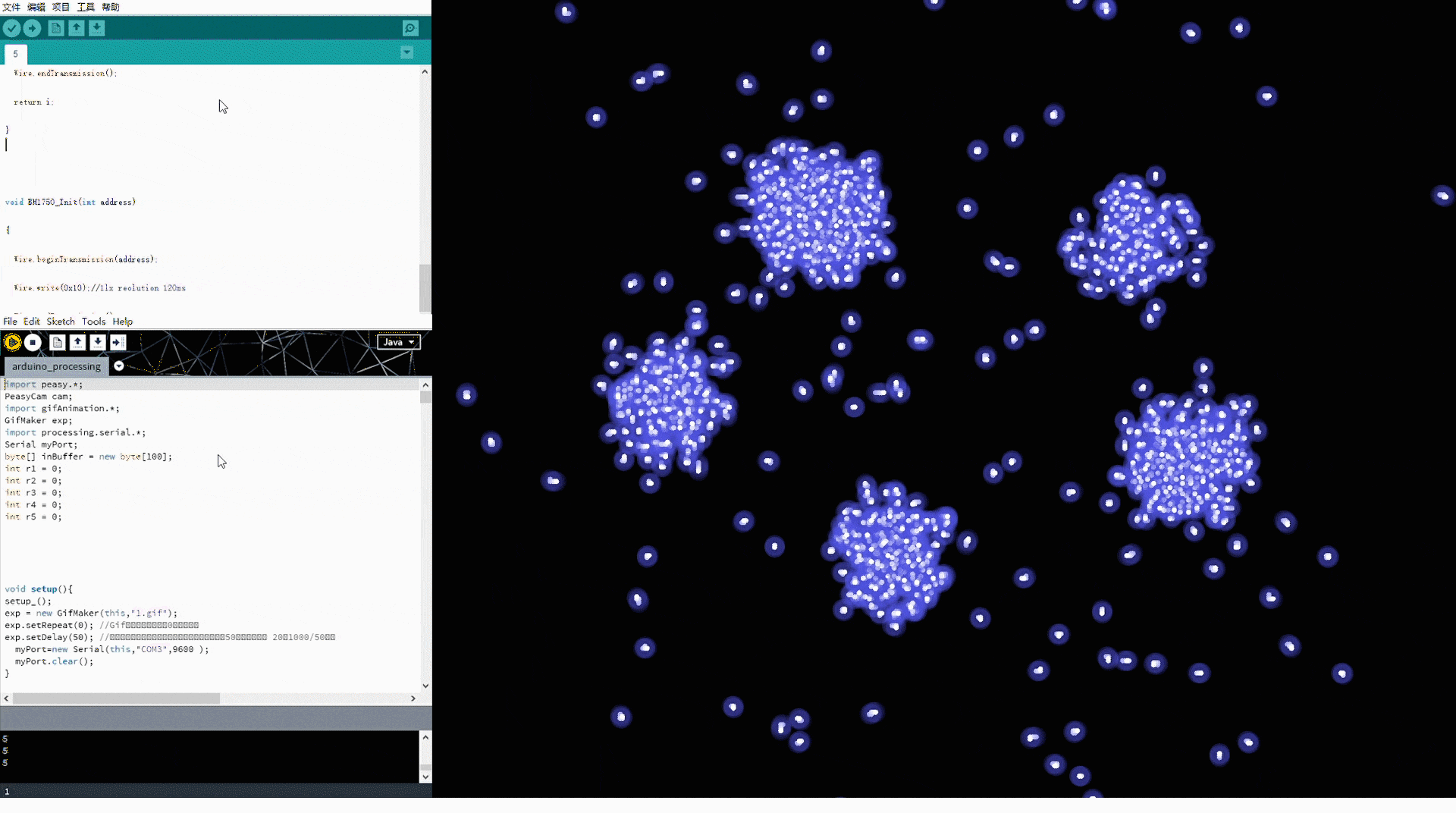


The rheostat at the rotating axis can measure the inclination angle of the pipe quantitatively. If the pipe rotates clockwise, the resistance will increase. When the pipe rotates counterclockwise, the resistance decreases.
The value of the resistance desides the attraction or repulsion force to the scattered point at the corresponding coordinates.
Interaction relationship








Before the snail lands, the tube is evenly filled with plant leaves in a horizontal state. At this time, the scattered points on the interface gather at the center point. it means that the snails have not yet begun to invade other regions.
When a viewer moves the snail to the right end of a certain pipe, the pipe rotates clockwise, and the increased rheostat resistance value will enlarge the attraction to the circular scattered points on the corresponding coordinates, symbolizing the beginning of the invasion there.








As the snail creeps and gradually consumes the leaves, the weight distribution in the pipe moves to left, so the pipe rotates counterclockwise, and the resistance value of the rheostat begins to decrease.
When the rotation angle of the pipeline exceeds the set threshold value, the attraction force of the corresponding coordinates to the scattered point converts into repulsion force, then the scattered points start to spread outward and would be converged to other coordinates.
This means that the snails there have depleted the vegetation resources and started a new invasion process to the rest of the area.
BUILDING and ASSEMBLING
Building process of the device for GIANT SNAILS










Building process of the device for CRAYFISH








.jpg)

EXHIBITION DISPLAY DESIGN
Arrangement in the exhibition space

Plane layout of devices & Operation guidance for viewers




Clip the snails from the container into the pipes by tweezers to make an INVASION. You can also add vegetables into the pipes. Observe the inclination process of the pipes and the moving trend of the patterns above, which are caused by the snails movement and the consumption of vegetables. Feel how your actions affected the whole system balance.

CONTROL GROUP
Rice seeds were planted in the same soil as Hani terraced fields in Yunnan province. Water droplets dripping from the tank are to simulate the natural rainfall condition.
By referring to the isometric line and the height marking line, the rate of SOIL EROSION in the terraced fields without crayfish invasion can be observed directly.

TREATMENT GROUP
The soil composition, height and gradient of the mound, species and density of seeds planted were the same as those in the control group. Besides there are 16 light sensors evenly buried 1 cm below the soil surface. Once the light sensors are exposed to the soil surface due to soil erosion, the pattern on the wall will change. By referring to the isometric line and the height marking line, you can also observe the rate of SOIL EROSION in the terraced fields under crayfish invasion.

EXHIBITION EXPERIENCE
OPENING: BACKGROUND INTRODUCTION
OUTLINE the EXHIBITION to AUDIENCES
.jpg)
We introduce the exhibition background and the operation methods through the light board to audiences.

MAIN: OPERATION PART 1
INVASION of CRAYFISH
1. Escape occurs Create invasion

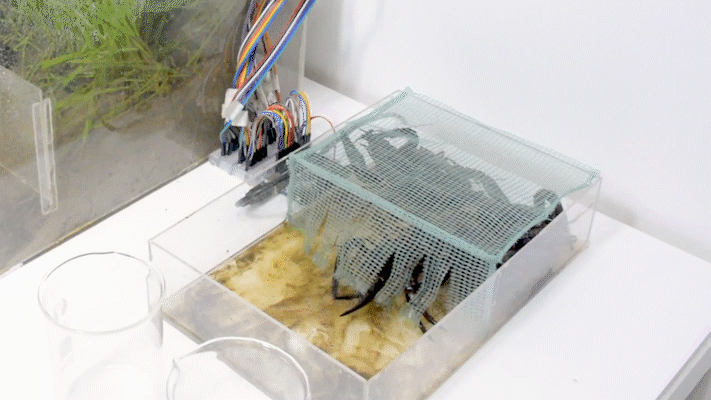
Transfer the fleeing crayfish from the net cage to the simulated terrace field. In this way, let the audience know the invasion path of crayfish.

cmyk_edited.jpg)
2. Digging & destroying... Rain falls


Burrowing
to hide
When the soil has been loosened, audiences then pour water into the upper perforated tank to simulate rainfall, the natural trigger of soil erosion.
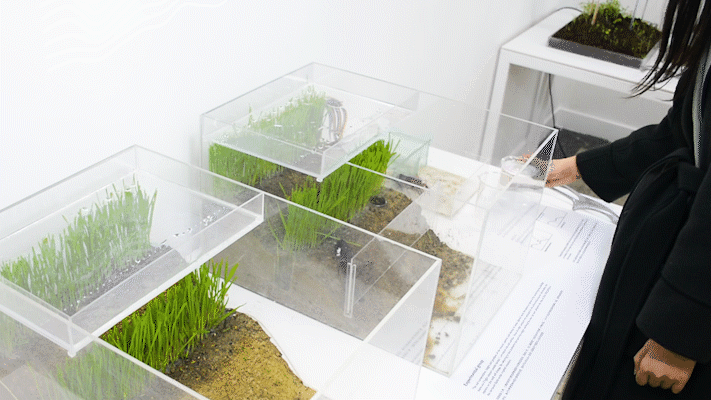
cmyk_edited.jpg)
3. Soil flushed Terrace collapsed


Audiences can observe the differences of the terrace slope and the soil content of the puddles between the experimental group and the control group.
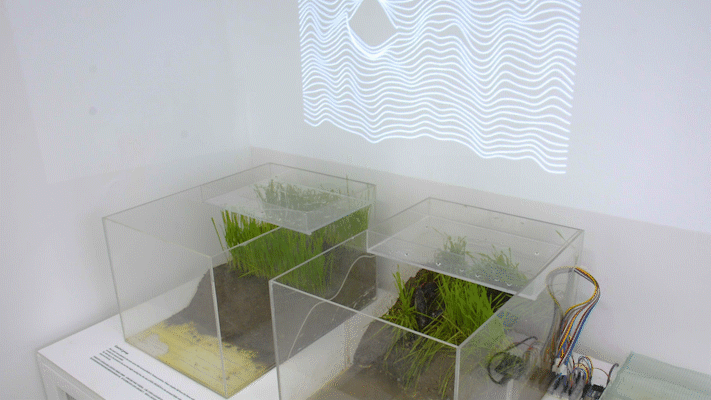
Bare light sensors transform
soil loss into vivid visual
patterns to strengthen
audiences' impressions.
cmyk_edited.jpg)

MAIN: OPERATION PART 2
INVASION of CRAYFISH
1. Attach on Lorries Launch and invade


Transfer the attached snails from the lorry model into the tubes. This symbolizes snails' invasion to a new environment caused due to the logistics industry
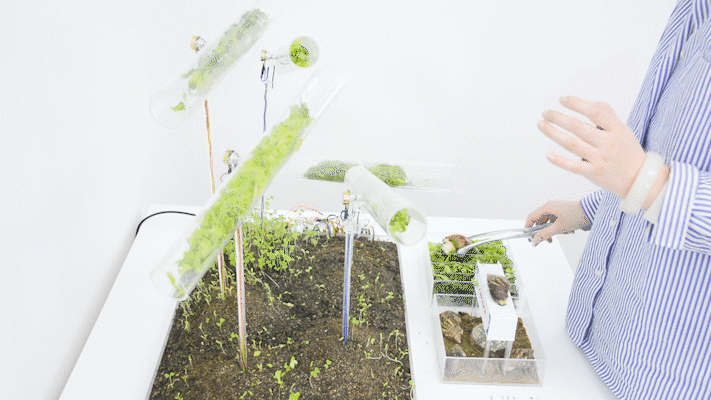

2. Consume various plants... influence the balance

.jpg)
Fill the pipe with leaves of different plants for snails to eat. This means that the destruction of local vegetation by snails has officially begun.
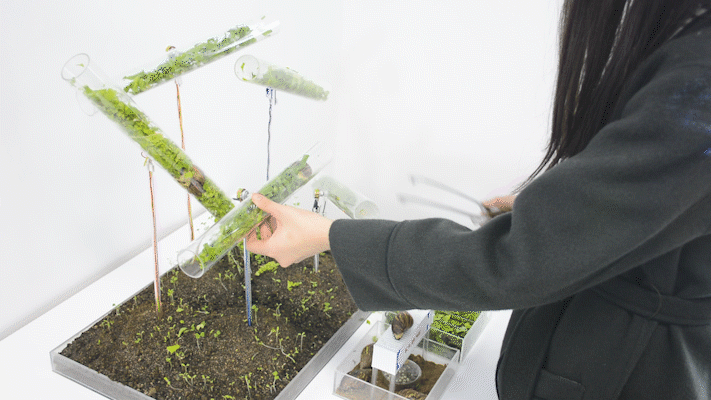

3. balance broken Invasion scope expends


As the leaves are consumed by the snail, the weight distribution of the pipe is constantly changing, and the rotation angle will control patterns on the wall.
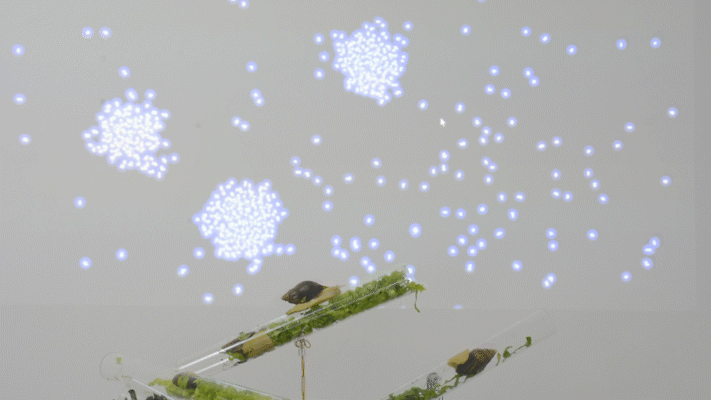

END: SOUVENIRS
PROMOTION MATERIALS



